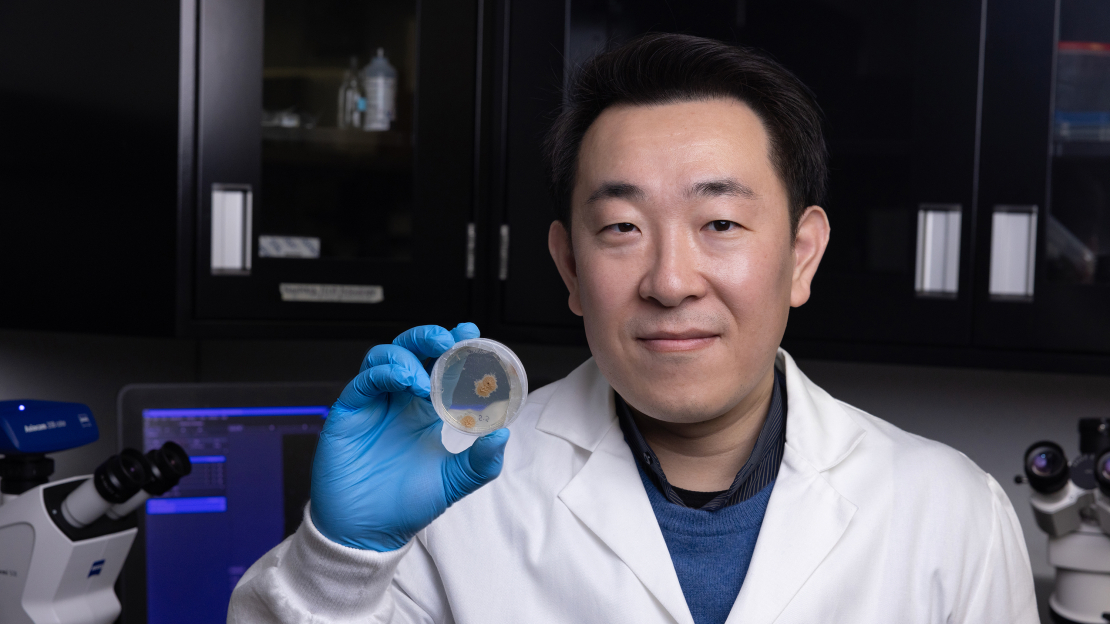U of T Scarborough researchers have decoded the genome of a gut-dwelling fungi that might unlock clues to fighting deadly mosquito-borne diseases (photos by Don Campbell)
January 23, 2025
By Don Campbell
U of T Scarborough researchers have successfully sequenced the genome of a relatively unknown, tiny fungus that lives inside the gut of mosquitoes.
Researchers hope by decoding the genome of Smittium minutisporum and other related fungi, it might one day be harnessed as a tool in controlling mosquito-borne diseases like malaria, Zika and pediatric encephalitis.
“We know so little about these types of fungi, yet their role in the mosquito ecosystem could be pivotal for understanding disease transmission,” says Yan Wang, assistant professor of biological sciences at U of T Scarborough and co-author of the study.
Yan Wang is also a member of the Emerging & Pandemic Infections Consortium.
The research, published in the journal Genome Biology and Evolution, focused on the fungus found in the gut of the eastern treehole mosquito, a carrier of the La Crosse virus, known for causing paediatric encephalitis.
Mosquito guts host a wide range of microbes such as bacteria, viruses and fungi, and they can have an impact on a mosquito’s physical traits, even influencing its genetics. Fungi can get inside a mosquito’s gut by being ingested or by penetrating the mosquito’s cuticle (outer body layer). Despite these important host-parasite interactions, Wang says gut-dwelling fungi are often overlooked and their interactions with mosquito hosts remain even less understood.
By understanding how the fungus interacts with its host at the molecular level, he says researchers might be able to identify vulnerabilities that could be used to disrupt mosquito development or reproduction. Researchers might also be able to eventually introduce a modified fungus that can target infected mosquitoes or even the pathogens inside them.
“It might be possible to develop fungal-based tools that are specific to mosquito hosts,” says Wang, who received funding from the Natural Sciences and Engineering Research Council and a U of T Connaught New Researcher Award for the work.
“So one day it could lead to the development of environmentally-friendly ways to directly address threats posed by mosquito-borne diseases,” says Wang.
Mysterious missing genes
Wang and former U of T Scarborough undergrad Anusha Prakash used cutting-edge PacBio sequencing technology to achieve the most detailed genome assembly of Smittium minutisporum ever acquired, surpassing previous fragmented attempts that used older sequencing techniques.

Assistant Professor Yan Wang pictured above at his desk, is an expert in the genomic evolution of fungi
Wang says using PacBio technology allowed them to explore the genome in such unprecedented detail that they revealed key features previously missed. One of the most surprising discoveries was a 20-per-cent loss of genes over its 200-million-year evolutionary history living inside the guts of mosquitoes compared to related fungi that live outside. The relatively large number of gene losses in the fungus may hold clues to how the fungus co-evolved with mosquitoes.
“We believe these genes were lost because they’re no longer needed. The fungus has adapted to rely on its mosquito host or co-existing microbes for survival,” says Wang. “In other words, it’s very dependent on the environment inside the mosquito gut.”
Wang says the fungus was likely responding to the specialized conditions that are constantly fluctuating inside the gut due to changes in food particles, immune responses and interactions with other microbes.
The PacBio sequencing took place at the Centre for Applied Genomics at the Hospital for Sick Children, while the fungal culturing, DNA extraction and computational analyses were done by Wang’s lab using Niagara, a supercomputer owned by U of T.
While the fungal samples used in this study were originally collected in South Carolina and deposited at the United State Department of Agriculture, researchers in Wang’s lab are collecting fungal samples across the Greater Toronto Area, including the Rouge National Urban Park, where they are looking at local and invasive mosquito species. Part of this work was recently published in the journal Botany, which included discovery of fungal species never collected before in Canada.
The story was originally published on the University of Toronto Scarborough News website


